
If life were predictable, it would cease to be life, and be without flavor.
Eleanor Roosevelt
Visit our shop for cool triathlete merchandise!
Subscribe to receive updates and exclusive content!
Most cyclists feel a need for indoor bike trainers every now and then. Sometimes, it’s because weather outside sucks so badly that going outside is not really an option. For some, it’s a matter of logistics – can I put dinner in the oven and get my workout done? Maybe squeeze a ride in while kids are napping? It may not be a perfect replacement for a real ride, but it’s something and will need to do in a pinch. So this week, we’ll talk about your options.
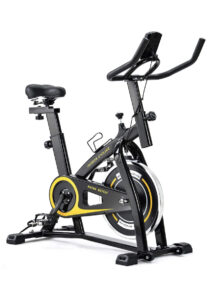
The first option you have is a stationary bike. We’ve all seen them at the gym before. They are common place and are definitely a way to go.
Indoor bike can accommodate various family members with simple adjustments of the saddle or handlebars. Depending on the type you go with, you may have programs you can set up or can at least change resistance without getting off the bike.
Another pro that’s hard to deny: you don’t need to use your regular bike. Ok, so this may be a double-edged sword. On one hand, it’s nice that you don’t risk scratching up your ride and don’t have to go through the process of setting it up every time you want to hit the road and then be back indoors. On the other hand, if you want to get comfortable on the real thing in advance of a long race, this may be more of a con.
An indoor bike costs more than just a stand where you put your bike. It also can’t be moved as easily – these things are heavy! However, if you have plenty of room and you can set it up in your home gym, then it’s not a problem.
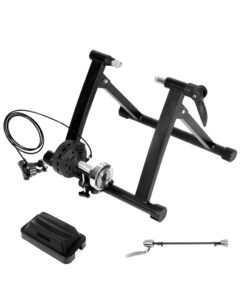
This is the way I went and it’s probably the cheapest way to go. This category is so broad that there are two subsets: ones that are compatible with Zwift and ones that are not.
They are definitely on the cheap side. Or at least you can find cheap options. You get to use your own bike, so that’s great if you want to make sure your form is correct. I also appreciate that if need be, I can easily fold it up and put away in my closet.
Some are loud… Yeah, they can drown out other sounds. Although probably not loud enough to wake a sleeping kid. They can also be a pain to set up, which if done regularly, can be a total turnoff.
As I mentioned earlier, there are different levels of sophistication for these trainers and it can make a huge difference. Some are compatible with Zwift and such and some are not. If you have Zwift, then you can join rides with other people, have varying courses and be engaged. If not – your only way to change resistance mid-ride is through switching gears. It’s also easy to forget that you’re supposed to keep going, as it gets monotonous.
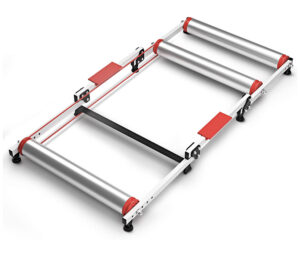
I have mixed feelings on this…
Rollers are relatively cheap and easy to pack, so they definitely have this going for them. You get to use your own bike, too! They also force you to focus on what you’re doing – you are on a regular bike, so you have to make sure you’re staying up and in your area. This kind of a ride is great for your core!
So you have to work on your balance… There is a flip side: potential for a crash. If you’re trying to squeeze in a workout while kids are asleep, this is definitely a problem. I am also not sure how long one can last on one of these.
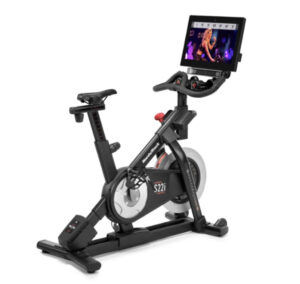
By all accounts, an expensive options, whether you go with Peloton itself or one of their direct competitors.
It’s a whole workout system and a lifestyle! You can go for a regular ride or choose a course. As with regular indoor bike, you can easily adjust for different family members.
Have I mentioned it’s expensive? And it’s not just the initial purchase (which is bad enough): if you want it to have all the fancy functions, you have to pay a monthly subscription!
Other cons of Peloton-like bikes are the same as those of a stationary bike: you need a place to put them. They are heavy. And they don’t really feel like the real deal.
As with many other things, both in training and in life: it depends on your personal circumstances. How price sensitive are you? How much room do you have for it? Do you have a real bike you want to use? I hope this helped some with the decision making process.
And as always: see you on the roads!
Alcohol in endurance training is most definitely a contentious subject. On one hand, many enjoy a cold one as a reward for work well done. On the other, I don’t think anybody would argue that it’s the healthiest beverage out there. So how does it impact my endurance racing and training?

We know there are many options for alcohol intake. You may be more of a wine or a beer person. Or are you one of the fans of mixed cocktails? I am trying to decide if this picture is telling or confusing… I ever drink only one type of alcohol and you can probably tell from the picture which one 😜.
Alcohol can be good for you if you drink it in moderate amounts. And no, binge drinking with your frat bros is not moderate, even if you do it only once a month. Moderate drinking is defined as one serving for women and 1-2 servings for men. In this case, serving is a glass of wine or a 12oz bottle of beer. If you want conversion to other alcohols, you may need to look it up. On the other hand, I don’t think I have ever heard of other drinks being good for you (unless you count them being a social lubricant as a benefit).
Before we go any further: your body’s reactions to alcohol are unique to you. There are some health conditions that make ingesting any amount of alcohol incredibly dangerous. Benefits listed below are meant for healthy adults without any additional risk factors.
According to Mayo Clinic, moderate amounts of alcohol may possibly decrease risk of heart disease and diabetes. But even they didn’t sound 100% convinced. I can’t speak to your risk of developing diabetes, but I am going to guess that if you are here, you are probably addressing your heart disease risk through exercise.
No good news in here… Actually to the extent that I have a hard time choosing where to start…
Let’s go with this: it’s totally empty calories. Each gram of alcohol converts into 7 calories. Unfortunately, it metabolizes into fat, not glycogen, and it can’t be used as energy. It gets stored in the liver (fatty liver, anyone?) and flow in the blood stream, increasing your chance of heart disease. Full disclosure: this discovery confused me a bit, as haven’t doctors said something about a glass of wine per day being good for preventing heart disease? Anywho… Alcohol is not good source of energy.
Alcohol can irritate your GI tract, which heavy drinkers may have seen more acute symptoms 💩. But even without that, unhappy bowels mean poor absorption of vitamins, minerals and other nutrients. Booze causes also general metabolism problems through impairing liver function, further compromising your ability to nurture your body properly.
As a diuretic (more on that later), alcohol removes magnesium and calcium from your body. That’s a recipe for cramps right away and osteoporosis in a long run right there!
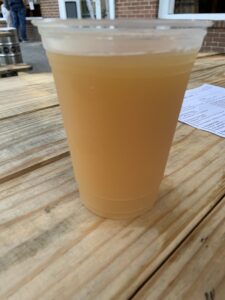
How many times have you heard people say that they want to cool down with a cold one at the beach/ by the pool? Probably like me: way too many. Alcohol is actually a diuretic, which means it removes more water from your body than you take in. Not exactly the smartest idea when you are in the heat and are trying to stay hydrated, does it?
Oh, and since we are already on the issue of heat: it impairs your body’s ability to regulate temperature. On one side, you do have heat and your body’s ability to properly cool itself. On the other is feeling hotter than what the conditions are really like, leading to excessive loss of heat. You may end up way underdressed when going outside into frigid air. That’s inadvisable, whether you’re heading out for a run or just walking home down the street.
Based on everything said before, I don’t think it will surprise you to hear that alcohol will make post-race/ workout recovery harder.
If you are an endurance athlete, you are likely seriously dehydrated after your race or a particularly long session. You are most likely in no position to lose any more water, at least not until you rehydrate properly. So please don’t try to rehydrate with a beer!
So you depleted your glycogen stores? Sad news: alcohol may make it harder for you to replenish them. And that’s not even considering your attempt to use beer calories as replacement for the ones you just burned.
Ok, here is one I have been guilty of in the past… So you come home after a marathon and EVERYTHING hurts from pounding the pavement for 4+ hours (in my case). A nice little beer will make you forget the pain, right? Well, that may be true, but… Alcohol slows down healing. And it’s not just big injuries, like twisted ankle or a pulled muscle. We are also talking about micro-tears to your muscles sustained during exercise. Not ok! One of the reasons this happens is because alcohol dilates your blood vessels, which is exact opposite to what you’re trying to do when you ice sore areas.

You know that one, right? I don’t think it really requires much of explanation to anybody who has ever drunk alcohol: it impairs your eye-hand coordination, makes your moves sloppy and takes away a few IQ points. Working out after a drink is a total no-no.
Biking under the influence is as bad as drunk driving. In fact, many places have laws that it is a DUI when you’re caught pedaling away with above-limit blood alcohol levels.
Running after a shot or a beer? You already made your body work hard to dispose of the alcohol, you’re dehydrated and now you think you can just go for a run? I am not even talking about your performance being impaired. Just not tripping over your own feet can become a challenge!
Don’t ever drink and swim. To be fair: alcohol and water don’t ever mix. I know plenty of people think that drinking on a boat is awesome, too. Just wait until you’re back safely in the marina…
Weight training and booze? Oh, yeah, I am sure that all those super-heavy machines are totally safe when your moves are already sloppy and your muscle aren’t in top shape 🥴.
Bottom line of this section: don’t drink just before or during your workout! Hangover is in this class, too…
Alcohol can be fun and if you are an adult, you are free to make your own choices. However, it’s not indifferent to your body. As such, you should evaluate your goals and whether they are compatible with occasional indulgence in an adult beverage. Overall evidence, though, says you should limit them.
What is the impact of caffeine in endurance sports? Does it help or hurt my performance?
I once showed up to a work event and somebody laughed that they didn’t recognize me because I wasn’t holding a cup of tea. So yeah, it’s safe to say I drink a lot of tea. I may have an occasional soda, but I am actually completely immune to appeal of coffee. It just smells really awful to me and I can’t get past that.
But enough on my feelings regarding caffeinated beverages. Let’s talk about their role in endurance sports.

There is a number of caffeine sources out there, some more appealing than others. The most commonly used probably is coffee and everybody thinks about it immediately. Personally, when I am looking for a caffeinated hot beverage, I’m going with tea. Another truly appealing source: chocolate. Just don’t tell that to pregnant women with cravings 😜 (my daughter had something against chocolate when I was pregnant with her, so at least that wasn’t a problem). There are also the cold beverages for those in a mood: sodas and energy drinks. And last and least: caffeine pills.
Is it just me or are all those options usually associated in people’s minds with sugar? I happen not to add any to my tea, but that’s besides the point.
Ah, the section everybody came here for! Here is a few things that caffeine will do for you in your endurance sports endeavors:
One of the studies I read about showed that taking some caffeine (either as a drink or a pill) up to an hour before you start your exercise may help you turn to fat for energy in the early stages of the race, rather than glycogen. If you look at my post about refueling during a long race or workout, you will realize this is actually really important and will help you have enough fuel for the entire race.
This one I actually didn’t know when righting about refueling mid-race: apparently having caffeine in your mid-race fuel increased your ability to burn carbs from those drinks by as much as 26%. Ok, that’s huge!
That’s always good… It has to do with increase in concentration of happy hormones in your brain. I wonder if that’s why people get so addicted to their morning coffee? I guess I have some non-athletic research to do out of my own, nerdy curiosity 🤓!
When you are doing a marathon or a long triathlon, you sure want to delay hitting the wall, or even just feeling tired, don’t you? Apparently caffeine can help. I suspect that at least one of the reasons for this is burning more fat earlier, allowing your already beat-up body access easier to burn fuel for longer.
Recovery drink containing caffeine can improve your glycogen absorption into muscle by as much as 66% comparing to decaf. I don’t know what about you, but I’m starting to see a pattern in here: caffeine helps us make better use of carbs in our lives. It may not be always what we want, but good to know.
This is a highly individual issue, although there are some common threads. For example, caffeine is a diuretic, which increases likelihood of dehydration. Fear not: it’s low potency, so as long as you don’t overindulge and compensate with proper hydration, you should be ok.
I don’t drink coffee, but I heard that it causes need to use the bathroom. This may be something to think of before drinking one, especially prior to running. If this is an issue for you, I would recommend replacing coffee with tea or caffeine pills. On the other hand, it can help you make sure you empty your bowels before a run and guarantee a race without an ‘incident’. I guess morale of this paragraph is: practice to see how your body reacts and act accordingly.
There is a number of other possible side effects, such as anxiety, headaches or muscle cramping. If you decide to use caffeine to enhance your performance, you should definitely test how your body reacts and repeat after me: nothing new on race day! Chances are you already know how your body feels about a cup of coffee or a soda. Caffeine pills are more of a niche thing, so read up on potency ahead of time.
Scientists from University of Sao Paulo tested how bad getting used to your daily cup of joe is in terms of giving you a performance boost. According to their study, people who were off coffee did get the largest boost and it did gradually taper off as athletes got their daily doses of caffeine. There was a big drop at day 11, but even after that, a boost persisted. Initial improvement was up to 5%, so if you’re trying to qualify for Boston or Kona and have just a couple of minutes to shave off, it might be worth it. But also remember: if you are miserable for weeks and can’t train properly, it may do little for you on race day.
So caffeine or no caffeine? That is the question. At the end of the day, like with most endurance sports issues: experiment and see how your body responds.
I have read many times that swimming tends to be the weakest discipline for triathletes, so I thought I’d write this week how to swim faster.
COVID-19 era has been hard on all of our athletic endeavors, but I doubt any were as impacted as swim workouts. I am sure at least some of you have access to open water where you are allowed to swim. Sadly, that’s not the case for me. I only got access to an overcrowded, short outdoor pool, making it hard to maintain this part of my triathlon preparedness. Now that they are reopening the pools, it’s time to focus on regaining my speed!

As Olympic swimmer Melanie Valerio once said: “He who pulls the most water wins, not the one who moves their arms through the water like a windmill.” And that’s where proper form comes in. I was lucky to have been a competitive swimmer when I was a little kid. It didn’t make me super fast, but it sure taught me the proper form. I know it may sound silly to some and plenty will say ‘I can already swim’, but many triathletes have questionable form, leading to wasted energy and slower speed.
Improving your form completely on your own is challenging to say the least. I have read a professional triathlete saying that when he started, his swim level was ‘won’t drown’ and local coach wouldn’t work with him. So he watched a lot of YouTube tutorials and filmed himself and eventually got good. Actually, more like great. It is a way to go, but I recommend getting a proper coach, if only for a couple of lessons. When deciding if you’re going to pay or go with the free route, always remember: you get what you pay for.
So swimming tends to be the ugly step child for many triathletes. You can’t win a race here, but you sure can lose it. It’s the first and shortest leg, giving you a lot of time to make up for bad performance later on. And that’s how many approach it in training: just enough not to embarrass themselves. However, if you want to get really good, you will need to put more effort into swimming, rather than phoning it in once a week.
If you are trying to just swim once per week, you are likely to stick to base and tempo swims. Those are great, I enjoy those, too. I find something peaceful about them. But add variety:
Use that kickboard. Try the paddles. Do a few laps with fins on. Do you know what these have in common? They force you to focus on one aspect of training at a time. Paddles and fins will help you build more muscle because they provide additional resistance. But in my opinion, one of the greatest benefits of working out with paddles is that they are unforgiving on your technique. You get immediate feedback if you’re sticking your hand in at an incorrect angle. And you can definitely feel the difference between an idle stroke and pushing water. Make sure to take advantage of these usually cheap tools to improve your swimming faster.
Then there is pulling a buoy. Or, if you’re doing open water swimming, maybe pull your kid on an inflatable? This will definitely help you build stronger muscle! It reminds me of running with a stroller or pulling a trailer when biking – oh, the relief when you lose that weight! You can go so much faster and so much further!
There are obvious workouts for swimmers, like back, arms and legs. And you should do your squats, bench presses and such – stronger muscle will help you become a faster swimmer. What I haven’t seen frequently mentioned online, but I find to be crucial is core. Just think how many different variations of ‘reduce drag’ there are in this article (and any other on the issue). Reducing drag is, in a nutshell, the art of keeping your body straight. And how do you keep yourself straight as an arrow? By engaging your core and making you that way of course! So keep doing your planks and side planks (and their variations) regularly!
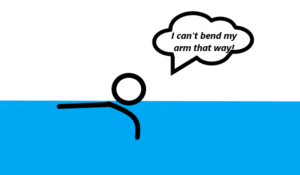
It’s a recurring theme in training: stretch. I am not talking about advanced yoga or anything fancy. But you most definitely should stretch some. I have noticed that some swimmers experience swim inefficiencies because they can’t move their arms just so or their body cramps us. This can be easily prevented through regular stretching.
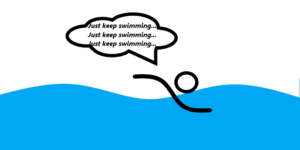
This is something I struggle with during long swims, especially in the pool. When you’re doing one lap after another, it gets mind numbing. There are no views to admire. Listening to music is hard. You can’t keep monitoring yourself on your watch. It’s just you and your thoughts. I wish I had something ground-breaking to say on this issue, but the matter of fact is that you need to learn to pay attention to your form and pace when you are swimming without losing your mind. During IM70.3 Gdynia, I just counted of my strokes and breaths. It calmed me down and helped stay focused. If you are thusly inclined, sing something in your head. Either way, find a way to provide your own beat.
Keep training and I will see you out there!